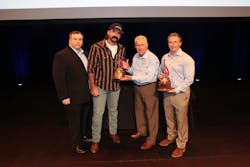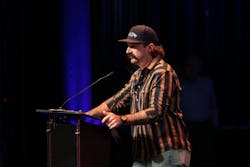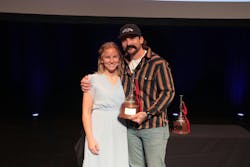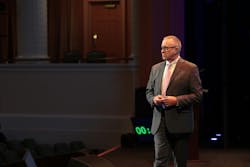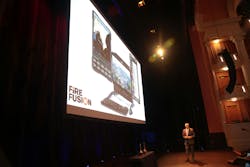FireFusion 2025: Valor Awardees Honored; Wearables Touted as Life-Saving Tech
After two days of attendees learning how technology can bolster and boost the fire service, FireFusion 2025 closed out with the presentation of the Michael O. McNamee Award of Valor and a keynote address on wearable technology.
St. Paul, MN, Firefighter/EMTs Jake Ryks and Mason Conlin received the awards that honor those who go above and beyond and make life-saving decisions on incident scenes.
In the early morning hours of Jan. 3, 2024, Ryks broke through the front door of a burning house with the knowledge that there were people still trapped inside. Knowing the urgency of the situation, Ryks entered the home alone to search for victims, while Conlin was getting the hoseline ready to go.
With next to no visibility, Ryks managed to maneuver his way into the closest bedroom, where he found a child that he brought outside to crews for treatment. He followed that same life-saving path two more times with a child being brought ouch each time. However, when Ryks returned to the front door with the third child in his arms, there was no one to hand off them off to - they were all taking part in medical efforts. Ryks ran the child to a staging area for EMS resources.
Ryks ripped off his SCBA facepiece and gloves and initiated CPR until other EMS crews could take over.
The victim count included six children, five of which succumbed to their injuries, and two adults, one of which did not survive.
Firehouse Editor-in-Chief Peter Matthews had the honor of presenting the awards to Ryks and Conlin at FireFusion. Conlin could not attend the presentation as he was recently deployed to the Middle East as a part of the Air National Guard.
“You join the fire service, and you never expect to stand on an award stage. You go to work every day and try your best to be good at what you do, in hopes that someday the training will pay off. That night, that training paid off,” said Ryks.
“My wife, Allison, has been supportive through the entire time. The time away, the conferences and the extra hours of training. I remember talking to her the next day, and she said, even if you never have another one, it's worth it now.”
Ryks emphasized that younger firefighters need to take training seriously because anybody could have ended up in the situation that he and Conlin were in that morning.
“When it doesn't feel like it matters to care, it does. That's the difference between accomplishing the seemingly impossible and having outcomes that are less favorable,” said Ryks.
Ryks was also able to talk to Conlin prior to the award ceremony and shared a couple thoughts on Conlin’s behalf.
“He sends his thanks to Firehouse. He just wants to reiterate, the same way that I would, that we are just a small part of a large response. We were two people in a response that was nearly 70,” Ryks said.
Ryks also credited the St. Paul Fire Department to have the ability to have their firefighters be EMTs and paramedic, because if they would have had to call for ambulances and paramedics to the scene, they wouldn’t have gotten the outcome they did.
“I feel that I was just a small portion of that response, and it’s important that that is known,” said Ryks after giving credit to the other first responders, nurses and doctors. “Thank you to the people that supported me, without that, I wouldn’t have the skill set Ido. Please care about training, because it is the difference maker.”
Wearables for the win
After honoring Ryks, Matthews introduced President and CEO of the International Public Safety Data Institute, John Oates, to close out the conference with a message about the intersection of wearable technology and firefighter health and wellness.
Oates opened his keynote by saying, “A simple time piece on our wrist can give us insight not only to us, but our health and ability.”
The electronic device is worn on the body, such as a smartwatch or fitness tracker that collects and transmits data. With the focus on wearables and the theme of the conference, Oates thought the alignment was perfect, because they are literally fusing technology with the fire service.
The key components of wearables that Oates shared were:
- Wearable: Worn comfortably
- Connectivity: Wireless technologies like Bluetooth or Wi-Fi
- Sensors: Various sensors to track physiological and environmental data
- Interactivity: Allow users to interact by receiving notifications
Why wearables matter
Through Oates’ research, he reflected on different examples of how the military is using wearables to improve their life and performance. He referred to a user quote of how wearables monitor a myriad of physiological parameters and how they felt safe pushing themselves, because if they started to break a safe limit, they would be attended to because of that wearable technology.
“If you don’t remember a thing I say the rest of the day, remember this: Two of the greatest predictors of health are sleep and hydration,” said Oates.
Then Oates asked how the fire service can sustain that level of health regarding sleep and hydration. He followed up by asking how FireFusion attendees can track the data, and how they can use it.
“Wearables can help solve that challenge if we're willing to take some risks, because it's an imperfect system, and we're not going to get it right all the time, but the benefit is greater than the challenge,” said Oates.
Oates explained how other industries are using wearables to enhance operations, such as the military, medical and construction industries. Those industries differ in what they aim to utilize wearables and typically have higher budgets than the fire service.
“Our threats are different. Our money is low, but there's still tremendous opportunities for us to be better,” said Oates.
This is where Oates brought in a project, “Feeding the borg," from Fire Chief Mike Binney of the West Metro Fire Protection District near Denver. The project is focused on data aggregation modeling and analysis of wearable technology. It’s about operationalizing data and conveying the story that is behind the data and not just presenting that data.
What else can we do today?
Oates spent a lot of time on the technology behind sensors and how sensors can provide proactive alerts and how they can be woven into clothing and PPE.
He also touched on data privacy, since that is a concern of vital personal data being tracked and analyzed. With legal concerns, discoverability, consent forms and location of data storage, you need to trust someone enough to give that data to. Oates suggested a need for a tool kit of current “best-ish” practice to implement.
Oates spoke on the technology of hearables and how those can be combined with radios to eliminate background noise and reduce the risk of missing a radio transmission on the fireground.
Oates mentioned embedding sensors in helmets and headbands that can help address concussion concerns in the fire service. Along with that, he stressed that even putting sensors in footwear can help monitor those stresses and strains put on the feet.
Putting it all together
While all this technology is great, it doesn’t pay dividends if there is no synergy. You must be able to display the data and use it in real time. Dispatch centers have that ability with dashboards to monitor that data as it is happening, therefore giving them the ability to make decisions right then and there.
Looking at the wider scope of things, there are four things to focus on when trying to put it altogether, according to Oates
- Next generation wearables: Integration with AI for predictive analytics, advanced environmental and biometric sensors and exoskeletons for firefighting and rescue operations
- Interoperability: Building wearables that work seamlessly across jurisdictions and agencies
- Ethical and transparent innovation: Establishing industry standards for development and deployment
- Vision for the future: Creating a fire service that is safer, healthier and more effective through strategic use of wearables
Overall, none of this does any good unless action is taken, Oates stressed. When action gets taken and utilization progresses, the fire service can be a more efficient and safer industry. It just starts with one decision.
“There’s no limit on how you can contribute to the fire service,” said Oates.
About the Author

Ryan Baker
Ryan Baker is a writer and associate editor with prior experiences in online and print production. Ryan is an associate editor for Firehouse with a master's degree in sciences of communication from the University of Wisconsin-Whitewater. He recently completed a year of teaching Intro to Public Speaking at UW-Whitewater, as part of his graduate program. Ryan acquired his bachelor's degree in journalism in 2023 from UW-Whitewater, and operates currently out of Minneapolis, MN. Baker, also writes freelances for the Ultimate Frisbee Association (UFA) in his free time, while also umpiring baseball for various ages across the Twin Cities Metro Area.
